Sulphur 389 Jul-Aug 2020
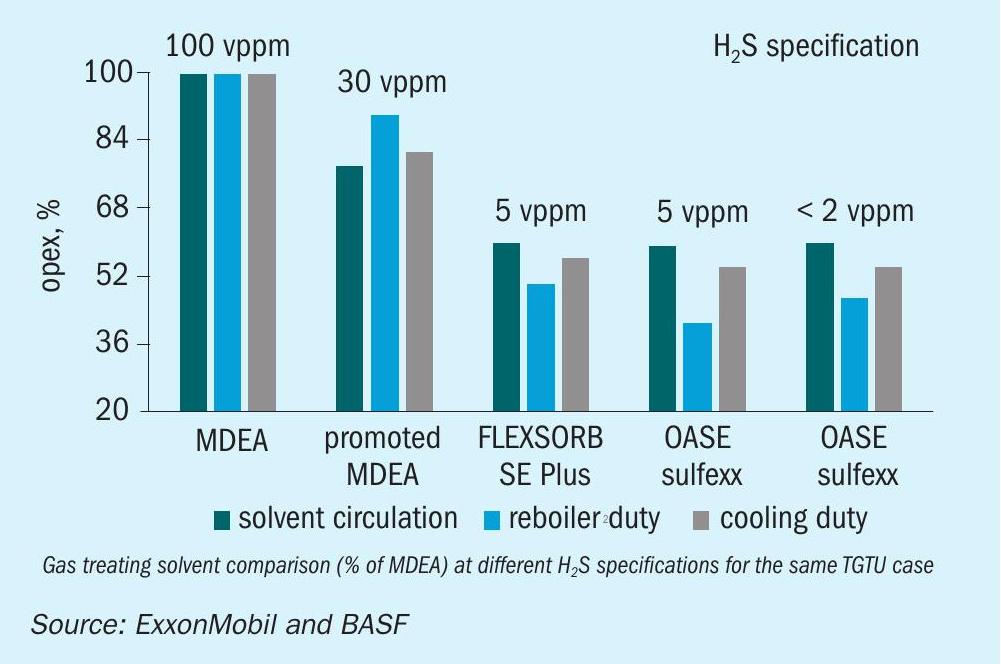
31 July 2020
Super selective hydrogen sulphide removal
SOLVENT TECHNOLOGY
Super selective hydrogen sulphide removal
The removal of hydrogen sulphide (H2 S) has become increasingly important as the oil and gas industry moves towards more efficient and sustainable production of lower emission clean fuels. BASF and ExxonMobil* have jointly developed a proprietary amine, OASE® sulfexx™ , to help refiners and gas processors achieve sulphur removal targets while reducing their carbon footprint via lower energy consumption. This new solvent technology is suitable for low and high pressure applications and shows superior performance characteristics over generic and promoted MDEA formulations, as well as sterically hindered amines such as FLEXSORB™ SE and SE Plus.
Technologies that provide selective removal of H2 S from gas streams are a key component of achieving more efficient and sustainable production of lower emission clean fuels. The current choices for selective solvents are based on generic or promoted methyldiethanolamine (MDEA) or severely sterically hindered amines. In this article, real operating data is presented to demonstrate the superior selectivity of OASE® sulfexx™ , a highly energy efficient gas treating technology jointly developed by BASF and ExxonMobil to help refiners and gas processors achieve sulphur removal targets while reducing their carbon footprint via lower energy consumption. The key to the technology is a new proprietary amine that can achieve high selective removal of H2 S while minimising the co-absorption of carbon dioxide (CO2 ). Selective treating permits full utilisation of the solvent for greater H2 S absorption, thereby reducing circulation rate and increasing energy efficiency. When compared to conventional amine solvents, the advancement is a considerable leap forward, leading to a new standard for gas treatment.
* The authors of this article are S. Nyuon of ExxonMobil Research & Engineering, J. Seagraves of ExxonMobil Corporation, G. Sieder and G. Vorberg of BASF SE and J. Habayeb of BASF Middle East.
The challenge
The world needs energy to support the growing population and rising living standards. The removal of H2 S is an essential processing step in the production of clean fuels to satisfy future energy demands. As new fuel sources are being explored, more stringent regulations on SO2 emissions are being implemented around the world. Many countries are intensifying efforts to lower carbon dioxide emissions to meet Paris Climate Accord commitments. One way to reduce carbon footprint is to reduce energy consumption and to use more sustainable technologies.
Regulations such as IMO-2020, as mandated by the International Maritime Organization, have resulted in the largest sulphur content reduction of a transportation fuel taken at any one time. Some refiners will revamp their facilities to meet these new regulations, while others will look toward processing less costly sour crudes in order to increase profitability. Improved technologies are needed to handle the increased sulphur loads on existing sulphur complexes.
Natural gas fields with compositions that were once deemed uneconomical or technically challenging to develop are now being re-evaluated as potential new sources of supply. Obviously, processing gas with extremely high levels of H2 S would necessitate the need for higher capacity solvents. At the other end of the spectrum, processing gas streams containing low concentrations of H2 S relative to CO2 will require advanced solvent technology to enrich the acid gas feed to the sulphur recovery unit. High quality acid gas feed enables stable operation of the sulphur recovery unit and reduces the fuel consumption of the process.
From a global perspective, the majority of the world’s sulphur production is now being produced in the Middle East. In this geographical location, high ambient temperatures combined with a lack of available cooling and process water require a robust solvent technology able to perform under these conditions.
Industry can expand to meet future demands and changing regulations by adding more equipment. However, this is expensive and may not lead to a reduction in emissions. Older technologies such as generic MDEA are less efficient for highly selective H2 S removal because of the capacity limitations of the solvent molecule. A better alternative is to use a more advanced energy efficient solvent to minimise modification of the existing equipment. For grassroots projects, the new technology will lower initial capital investments due to smaller equipment size and lower operating costs.
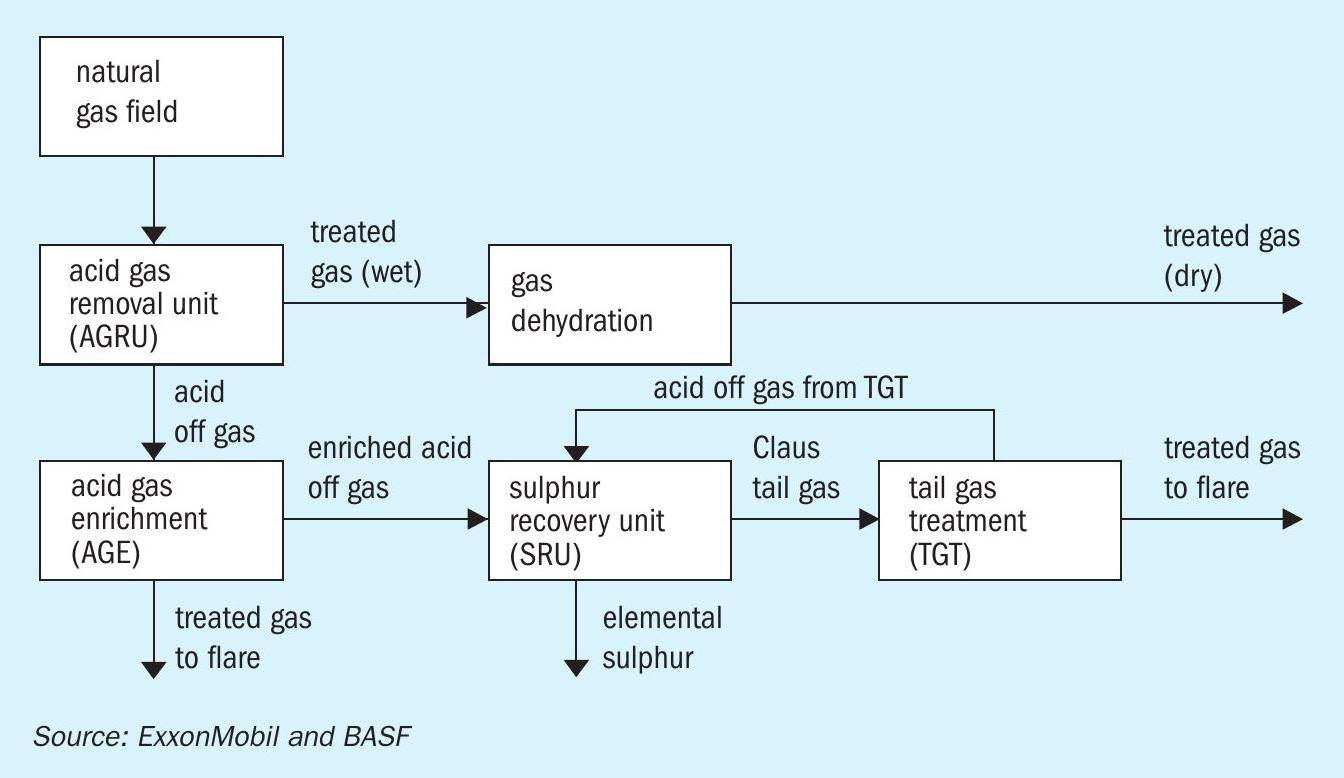
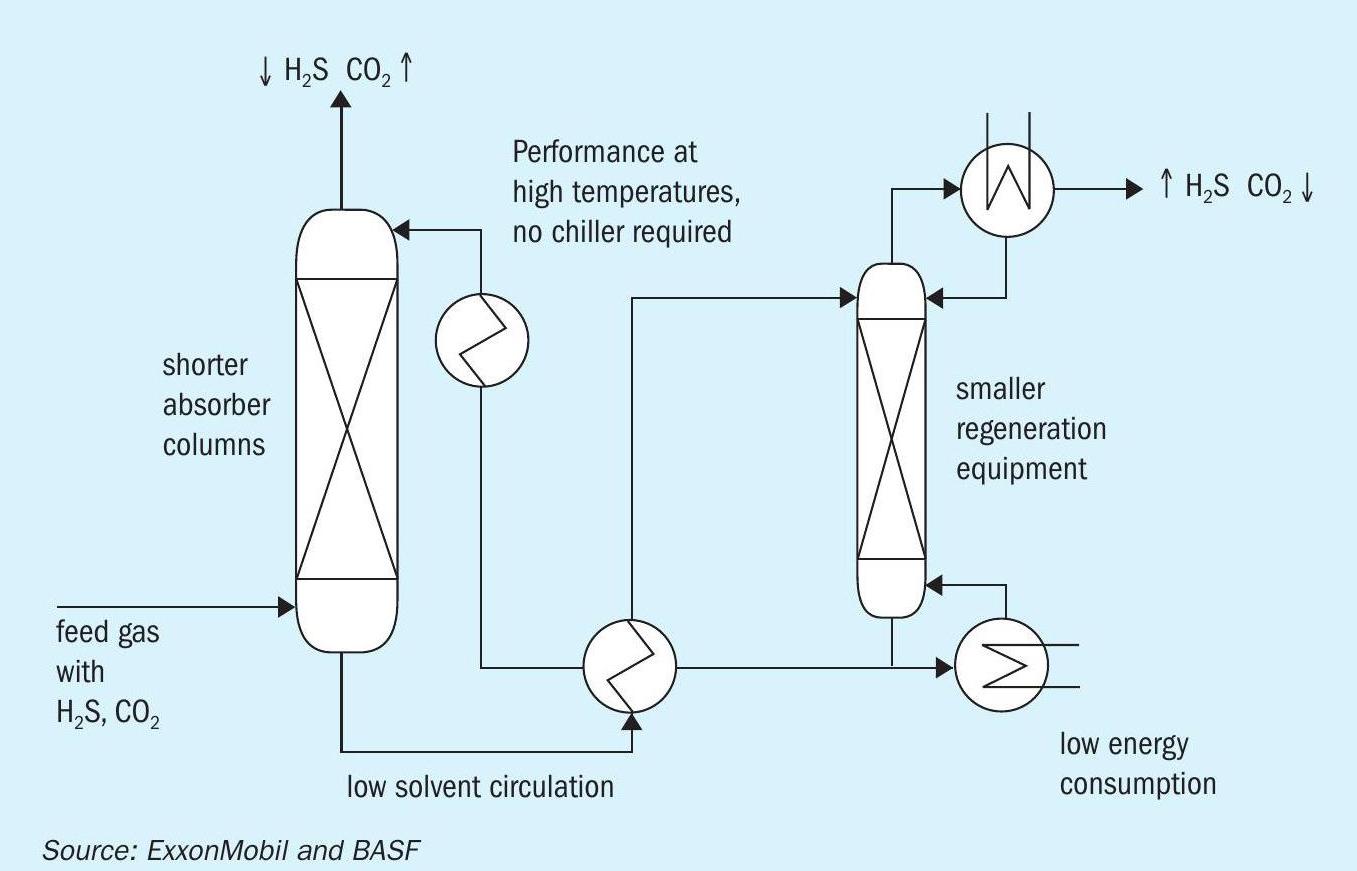
Benefits of selective treatment
OASE sulfexx exhibits superior performance characteristics over generic and promoted MDEA formulations, as well as sterically hindered amines such as FLEXSORB SE and SE Plus. The solvent is suitable for low pressure applications and even for selective high-pressure applications. The technology is suitable for use in Claus tail gas treating (TGT), acid gas enrichment (AGE), and high pressure acid gas removal (AGR) units where selective removal is required (see Fig. 1).
The new proprietary amine is specifically tailored to maximise H2 S absorption in the presence of CO2 . This property allows the solvent to achieve high H2 S cleanup and selectivity at low solvent circulation rates.
In grassroots units, this leads to substantial savings in investment and operating costs. In retrofit situations, the technology may be used to debottleneck the unit and achieve lower sulphur emission targets or allow the unit to achieve higher throughput with minimum hardware modifications. In both cases, the solvent improves the quality of the acid gas. Fig. 2 highlights the areas of the amine unit where the technology can provide benefits.
To illustrate the benefits of the new solvent, Figs 3 and 4 compare the performance of generic MDEA, promoted MDEA, and FLEXSORB SE Plus against OASE sulfexx in a typical TGT unit. These results were calculated using the OASE Connect design and simulation tool developed by BASF1 .
The feed gas to the TGT unit contains 2 vol-% H2 S and 10 vol-% of CO2 at slightly above atmospheric pressure. The lean amine temperature is set at 45°C. The feed gas flow is the same for all four cases. The results are normalised against generic MDEA. At these conditions, OASE sulfexx exhibited high H2 S absorption capacity and selectivity relative to the alternative amine solvents. These features translate into lower operating and capital expenditures (opex and capex). For example, compared to MDEA, the new solvent reduced the circulation rate by 40% and the energy consumption by over 50% (Fig. 3).
Fig. 4 shows the relative equipment costs for the TGT unit. The total estimated capex for OASE sulfexx is about 30% less than MDEA. The cost of cooling is particularly important to gas processing facilities located in hot, arid regions of the world. For instance, an increase in lean amine temperature will impact capex and opex significantly depending on the cooling medium. In locations where access to cooling water is limited, the use of air coolers will require higher capex in exchange for lower opex. However, once additional propane chilling of the solvent becomes necessary, opex and capex can easily rise threefold to fivefold. OASE sulfexx technology can be operated with lean amine temperatures that exceeds 55°C. The inherent heat tolerant properties of the solvent avoid costly investment and operational expenses associated with additional chillers.
Commercial demonstration
The sulphur train at a North American refinery consists of two Claus sulphur recovery units with one common TGT unit. The TGT unit is an original FLEXSORB SE design by ExxonMobil that was commissioned in 2010. Assuming 93% overall end-of-run recovery in the upstream SRUs, the FLEXSORB SE TGT unit was designed to achieve less than 250 ppm H2 S in the absorber overhead under all operating scenarios. The combined tail gas from the SRUs is sent to a hydrogenation step followed by a quench tower and then the FLEXSORB SE TGT unit.
The feed to the TGT unit contains approximately 2 vol-% H2 S and up to 7 vol-% CO2 . Just prior to the solvent swap to OASE sulfexx, the absorber outlet had an average of around 10 vppm H2 S.
OASE sulfexx fits into the refinery’s strategic plan to reduce their carbon footprint. The goal of the field trial was to improve the energy efficiency of the site by reducing the regenerator reboiler steam consumption.

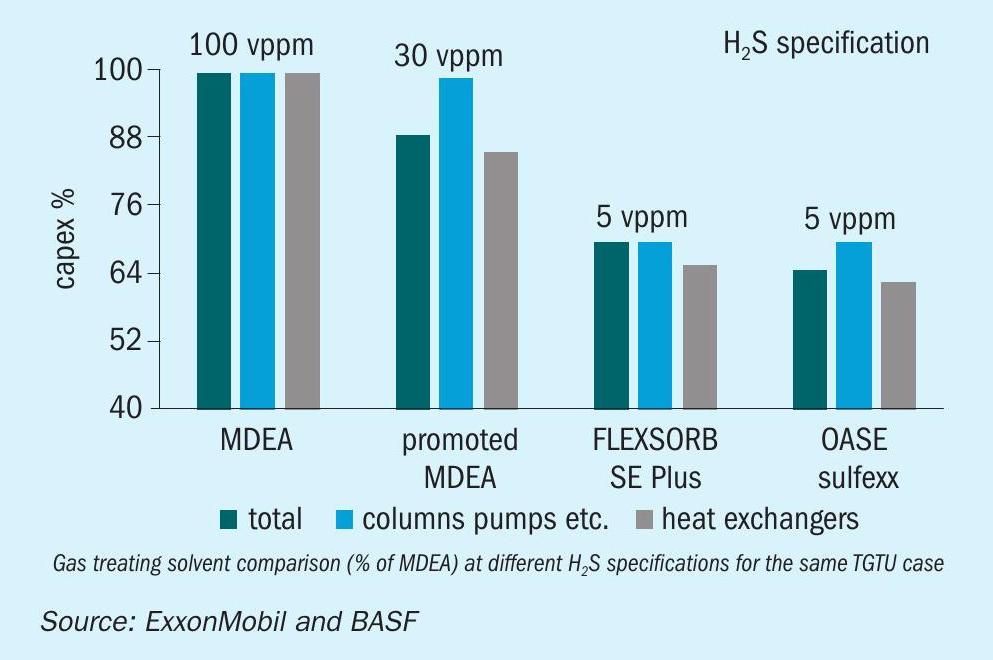
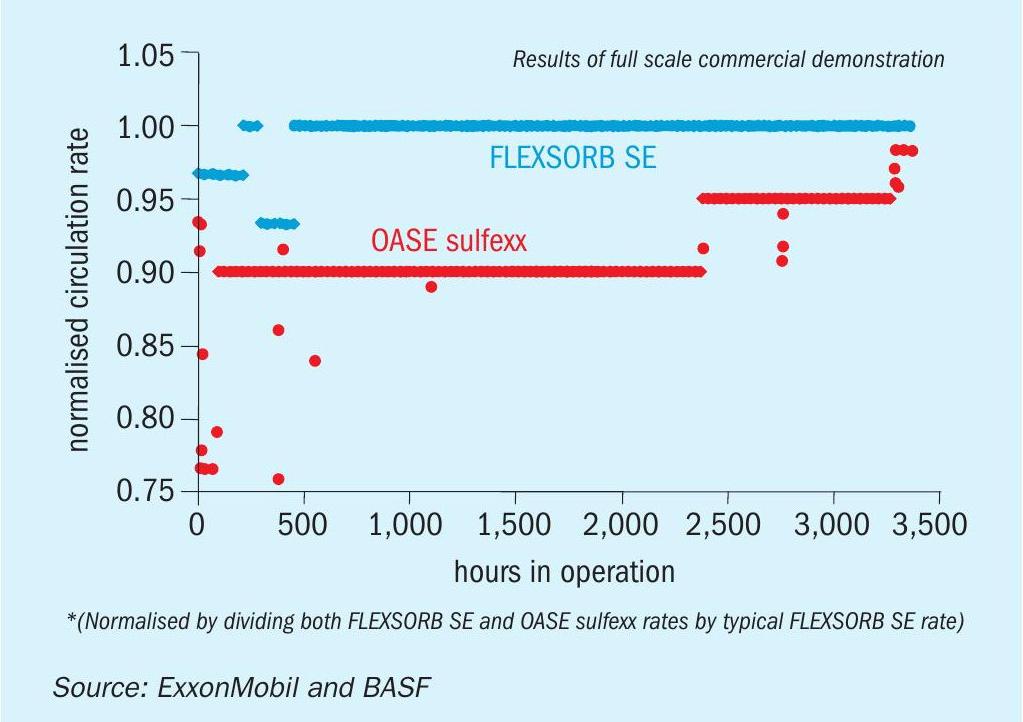
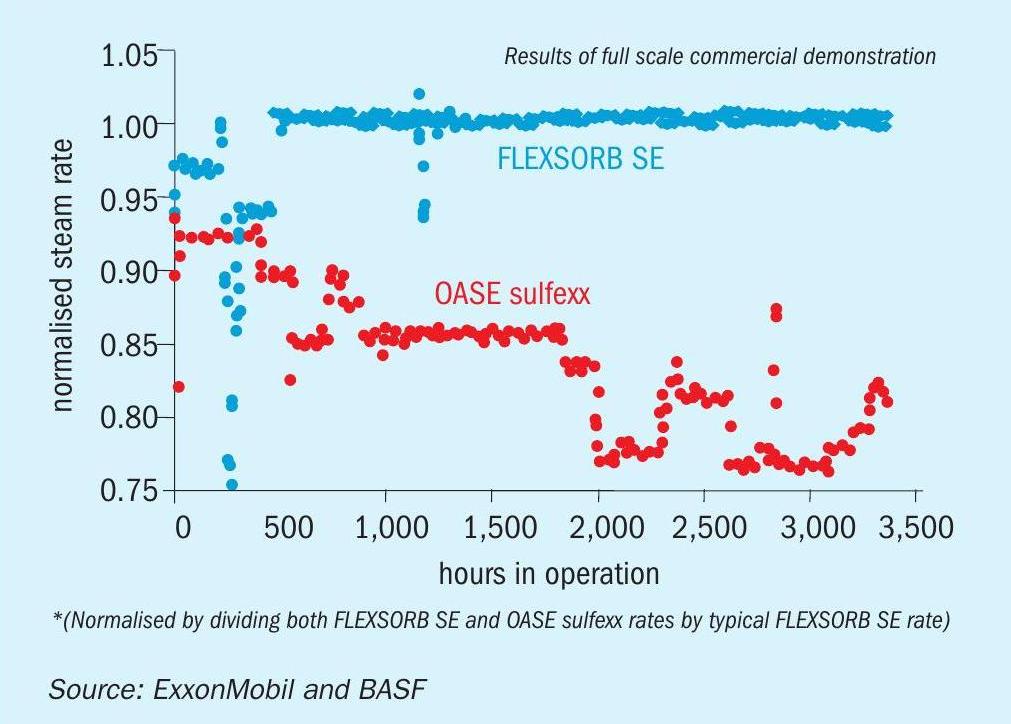
The FLEXSORB SE solvent was swapped to OASE sulfexx solvent during a very short three day turnaround. The system was drained and refilled with the new solvent. Prior to the swap, detailed gas analysis was performed by a third party testing service. Baseline data were obtained on the feed, treated and stripper acid gas streams to confirm the material balance. The gas analysis also served to confirm online analyser measurements. The analyses were then repeated during the OASE sulfexx performance test. The baseline data obtained from the unit showed very good fit and reproducibility.
During the initial days of the trial, the unit was run at different circulation rates and reboiler duties. As the trial progressed, solvent circulation and steam rates were adjusted to ensure that the performance was acceptable throughout the entire operating envelop. During these adjustments, the H2 S level was well below the 50 vppm maximum limit set by the test plan. These changes to the flowrates are reflected in the far left quadrant of Figs 5 and 6.
As a reference, performance data of FLEXSORB SE operating under similar feed gas conditions were overlaid in Figs 5 and 6. These figures show that OASE sulfexx can operate at 90 to 95% of the circulation rate of FLEXSORB SE, and approximately 75 to 85% of the steam rate of FLEXSORB SE.
Similarly, the solvent performance in the absorber was also evaluated. The average results of the tests are summarised in Table 1. With the absorber operating at less than 10 vppm H2 S in the overhead, OASE sulfexx showed improved selectivity over FLEXSORB SE. Tests showed CO2 slip improvement of 6% above the baseline on average. The high selectivity also reduced the amount of CO2 in the gas recycled back to the SRU.
As a next step, the two companies are conducting additional tests to further improve and refine the technology.
Reference







